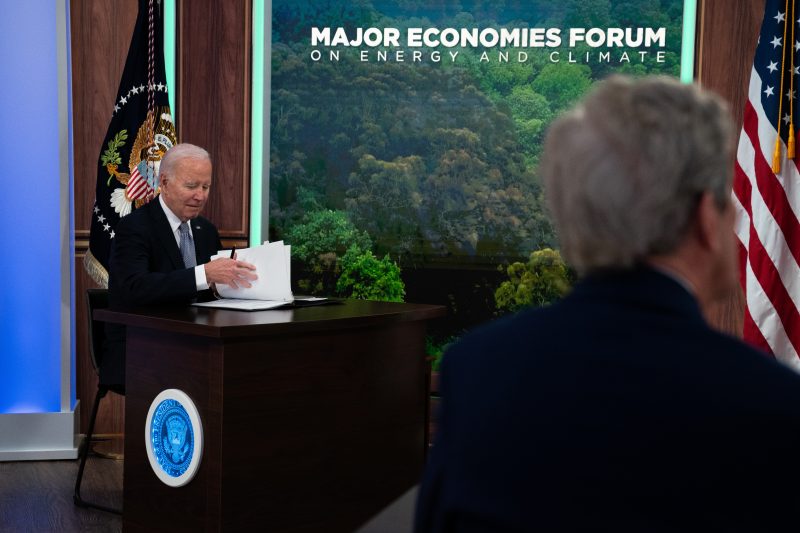President Biden was midway through a recent speech at a labor rally when he turned to an explanation of a kitchen-table economic philosophy that he says was formed, literally, at his parents’ kitchen table. “The press has now called [it] ‘Bidenomics,’” he said. “I don’t know what the hell that is.”
The crowd laughed as he offered, “But it’s working.”
Two weeks later, the White House has mobilized an entire week around elaborating on, reclaiming and defining just what “Bidenomics” is — something they have cast expansively as broadening and benefiting the middle class.
The president is scheduled to deliver a major speech on his economic vision Wednesday in Chicago with an eye to the 2024 campaign. His senior advisers issued a four-page memo on Monday highlighting the concept, with subheads like “Bidenomics is working” and “The American people strongly support Bidenomics.”
Biden’s newfound embrace of Bidenomics is in a sense a reflection of political reality. A president almost always gets saddled with the economy, whether conditions are good and whether he’s fully responsible. For the past two years, that has at times meant Americans were blaming Biden for inflation without crediting him for job creation, or punishing him for higher grocery prices without applauding lower drug costs.
But despite enormous job growth and a fast-paced recovery from the pandemic, Biden and his advisers have long been frustrated that the president is not getting more credit for an economy that by many measures is thriving. Employers added nearly 340,000 jobs last month, defying predictions and continuing a blistering expansion of the labor market. Yet inflation, while slowing to 4 percent in May, remains persistent in some of the areas that have hurt Americans’ budgets.
Just over a third of Americans (36 percent) approved of how Biden was handling the economy in a June Yahoo/YouGov poll, while a June Quinnipiac poll found that 24 percent of Americans rated the nation’s economy as “excellent” or “good.”
Most Americans arguably have no idea what Bidenomics means. White House press secretary Karine Jean-Pierre said it refers to helping middle-class Americans through efforts like spurring job growth, cutting drug costs and fighting “junk fees.”
“You don’t like Bidenomics? I think it’s pretty clever. It’s pretty good,” she said Monday when asked why White House officials have suddenly started using the phrase. “It makes good sense, Bidenomics. It kind of flows off the tongue really well.”
Gary Burtless, a senior fellow in economic studies at the Brookings Institution, credited Biden with passing major initiatives through a divided Congress, but he struggled to define what is specifically “Biden” about Bidenomics. “There’s not distinctive economic policy,” Burtless said. “I can’t think of what Bidenomics would be, really.”
He added, “He has sympathy for the blue-collar worker and would like to get industries back in the United States where we’re not so vulnerable to international interruptions in trade. But that’s more of an evolution than a distinctive new policy.”
For Biden, the twist — and the challenge — is that for much of his presidency, Bidenomics has often been a pejorative. It has been used most frequently by conservative opinion writers, derisively referring to economic policies that they argue triggered higher prices and record inflation.
The Washington Examiner ran a column in May 2021 headlined “Three pitfalls of Bidenomics.” The New York Post decried “The Bane of Bidenomics” in June 2021 and bemoaned “Death by Bidenomics” four months later.
The Wall Street Journal, assessing “Bidenomics 101” in July 2022, concluded: “The president doesn’t appear to know anything about how the private economy works.” On June 8, the paper ran a story headlined “Bidenomics and Its Contradictions.”
Later that day, during a news conference with British Prime Minister Rishi Sunak, Biden seemed to refer to that the story, publicly using the word Bidenonmics for the first time despite professing some bafflement about the term.
“One of the things that I decided to do — and I find that the Wall Street Journal — and I’m sure there is someone here from the Wall Street Journal and other publications that are talking about Bidenomics,” Biden said. “I didn’t realize it was — I had Bidenomics going.”
Embracing a term that was intended as an insult is a bit of political jujitsu familiar to Biden supporters, who had some success turning “Let’s go Brandon” — originally shorthand for an expletive about the president — into “Dark Brandon,” a meme of an all-powerful, edgier version of Biden.
The effort is also reminiscent of Biden’s onetime partner in the White House. Obamacare, referring the health-care law signed by President Barack Obama in 2010, was first used by Republicans to express their contempt for the Affordable Care Act, which they saw as an overbearing government program that would intrude into Americans’ medical decisions.
But within a year of its passage, the term “Obamacare” was used by both Democrats and Republican to refer to the ACA, as its supporters concluded that it made more sense to welcome the name than to fight it.
“I have no problem with people saying, ‘Obama cares,’” Obama said in 2011. “I do care. If the other side wants to be the folks who don’t care, that’s fine with me.”
Nicknames exhibiting derision or praise for a president’s efforts are most common when it comes to the economy, helping partisans deliver a stark message about an often complex series of policy choices.
“Reaganomics” and “Clintonomics” were often used to describe the economic approaches of presidents Ronald Reagan and Bill Clinton. They were more catchy — and longer lasting — than the more cumbersome, less defined “Bushonomics,” “Obamanomics” and “Trumponomics” (or, as Trump’s budget director, Mick Mulvaney, attempted: “MAGAnomics”).
Paul Harvey, the late radio host, is credited with popularizing the phrase Reaganomics. But the trend of grafting a president’s name onto the word “economics” stretches back for half a century, and there is little secret why it works better with some presidents than others.
“For the omics suffix to work, the president’s name must end in an n,” William Safire explained in a 1992 New York Times “On Language” column. “This all began when some of us in 1969 began pushing Nixonomics. (Although Johnsonomics would have been an effective neologism, it was not used, suggesting that Nixonomics was the form’s first presidential use.) Although there was some straining for Fordonomics and Carternomics, neither got off the ground because of the lack of the concluding n.”
Safire predicted — with some accuracy — that “now we are likely to have Clintonomics, described breathlessly at first as a new approach, and hailed when the economy turns upward; then, when the business cycle pushes the pendulum back the other way, Republicans will seize Clintonomics as their term of attack. Some linguistic trends are predictable.”
Daniel T. Rodgers, a Princeton University historian, said it’s not unusual for a president’s critics to tie his name to an unpopular policy or phenomenon — like Herbert Hoover getting tagged with “Hoovervilles,” the shantytowns that sprouted during the Great Depression. Presidents prefer to give their programs catchy titles, like Franklin D. Roosevelt’s New Deal or Lyndon Johnson’s Great Society, rather than using their own names.
“Franklin Roosevelt didn’t talk about Roosevelt-nomics. That would have been a mouthful anyway,” Rodgers said. “He talked about the New Deal.”
He added that a term like Bidenomics may suggest Biden’s approach has more coherence than it does. “In some ways, what Biden’s spokespeople seem to be doing is trying to clean up the impression they have nothing but a confused set of policies and that he’s been reacting piece by piece,” Rodgers said.
Because Biden’s name ends in an n, Safire’s assessment would seem to bode well for the longevity of the term Bidenomics. The fight has now been joined on whether it will be dismissive or laudatory.
White House officials, in stressing Biden’s focus on the middle class, are consciously making a foil of Reagan’s professed aim of shrinking government and cutting taxes, including for the well-off.
“If Reaganomics was based on the idea that if you cut taxes for the wealthiest corporations, the wealthiest people in the society, and then at some point the remnants of those will trickle down to the middle class and the working class, Bidenomics is the exact opposite,” Anita Dunn, one of Biden’s top advisers, said Monday on MSNBC. “Bidenomics says that the way you grow the economy, in this economy, is you grow the middle class.”
Asked if the White House is confident the rebranding of Bidenomics could change public perception about Biden’s stewardship of the economy, Jean-Pierre responded, “We’re going to try.”



























